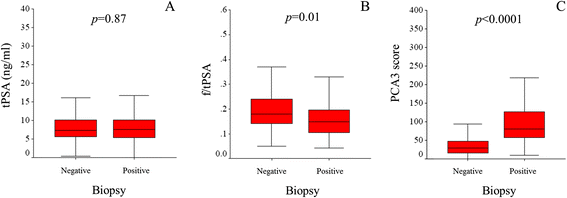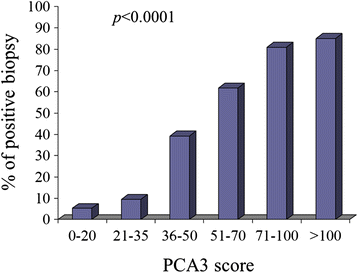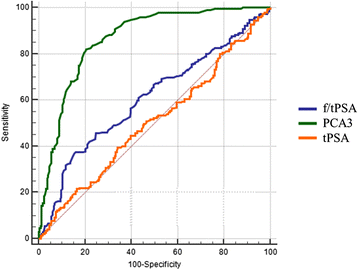PCA3 in prostate cancer and tumor aggressiveness detection on 407 high-risk patients: a National Cancer Institute experience - PubMed (original) (raw)
doi: 10.1186/s13046-015-0127-8.
Luigi Tomao 2 3, Anna Antenucci 4, Isabella Sperduti 5, Steno Sentinelli 6, Serena Masi 7, Chiara Mandoj 8, Giulia Orlandi 9, Rocco Papalia 10, Salvatore Guaglianone 11, Manuela Costantini 12, Giuseppe Cusumano 13, Giovanni Cigliana 14, Paolo Ascenzi 15 16, Michele Gallucci 17, Laura Conti 18
Affiliations
- PMID: 25651917
- PMCID: PMC4324853
- DOI: 10.1186/s13046-015-0127-8
PCA3 in prostate cancer and tumor aggressiveness detection on 407 high-risk patients: a National Cancer Institute experience
Roberta Merola et al. J Exp Clin Cancer Res. 2015.
Abstract
Background: Prostate cancer (PCa) is the most common male cancer in Europe and the US. The early diagnosis relies on prostate specific antigen (PSA) serum test, even if it showed clear limits. Among the new tests currently under study, one of the most promising is the prostate cancer gene 3 (PCA3), a non-coding mRNA whose level increases up to 100 times in PCa tissues when compared to normal tissues. With the present study we contribute to the validation of the clinical utility of the PCA3 test and to the evaluation of its prognostic potential.
Methods: 407 Italian men, with two or more PCa risk factors and at least a previous negative biopsy, entering the Urology Unit of Regina Elena National Cancer Institute, were tested for PCA3, total PSA (tPSA) and free PSA (fPSA and f/tPSA) tests. Out of the 407 men enrolled, 195 were positive for PCa and 114 of them received an accurate staging with evaluation of the Gleason score (Gs). Then, the PCA3 score was correlated to biopsy outcome, and the diagnostic and prognostic utility were evaluated.
Results: Out of the 407 biopsies performed after the PCA3 test, 195 (48%) resulted positive for PCa; the PCA3 score was significantly higher in this population (p < 0.0001) differently to tPSA (p = 0.87). Moreover, the PCA3 test outperformed the f/tPSA (p = 0.01). The sensitivity (94.9) and specificity (60.1) of the PCA3 test showed a better balance for a threshold of 35 when compared to 20, even if the best result was achieved considering a cutoff of 51, with sensitivity and specificity of 82.1% and 79.3%, respectively. Finally, comparing values of the PCA3 test between two subgroups with increasing Gs (Gs ≤ 6 versus Gs ≥ 7) a significant association between PCA3 score and Gs was found (p = 0.02).
Conclusions: The PCA3 test showed the best diagnostic performance when compared to tPSA and f/tPSA, facilitating the selection of high-risk patients that may benefit from the execution of a saturation prostatic biopsy. Moreover, the PCA3 test showed a prognostic value, as higher PCA3 score values are associated to a greater tumor aggressiveness.
Figures
Figure 1
tPSA (A), f/tPSA (B) and PCA3 score (C) values for patients negative and positive for PCa.
Figure 2
Relationship between PCA3 score and the percentage of positive biopsies.
Figure 3
ROC analysis with evaluation of the corresponding AUC for tPSA (0.505), f/tPSA (0.607) and PCA3 score (0.865).
Similar articles
- A comparative performance analysis of total prostate-specific antigen, percentage free prostate-specific antigen, prostate-specific antigen velocity and urinary prostate cancer gene 3 in the first, second and third repeat prostate biopsy.
Auprich M, Augustin H, Budäus L, Kluth L, Mannweiler S, Shariat SF, Fisch M, Graefen M, Pummer K, Chun FK. Auprich M, et al. BJU Int. 2012 Jun;109(11):1627-35. doi: 10.1111/j.1464-410X.2011.10584.x. Epub 2011 Sep 21. BJU Int. 2012. PMID: 21939492 Clinical Trial. - Prostate health index (phi) and prostate cancer antigen 3 (PCA3) significantly improve diagnostic accuracy in patients undergoing prostate biopsy.
Perdonà S, Bruzzese D, Ferro M, Autorino R, Marino A, Mazzarella C, Perruolo G, Longo M, Spinelli R, Di Lorenzo G, Oliva A, De Sio M, Damiano R, Altieri V, Terracciano D. Perdonà S, et al. Prostate. 2013 Feb 15;73(3):227-35. doi: 10.1002/pros.22561. Epub 2012 Jul 20. Prostate. 2013. PMID: 22821756 - Urine TMPRSS2:ERG Plus PCA3 for Individualized Prostate Cancer Risk Assessment.
Tomlins SA, Day JR, Lonigro RJ, Hovelson DH, Siddiqui J, Kunju LP, Dunn RL, Meyer S, Hodge P, Groskopf J, Wei JT, Chinnaiyan AM. Tomlins SA, et al. Eur Urol. 2016 Jul;70(1):45-53. doi: 10.1016/j.eururo.2015.04.039. Epub 2015 May 16. Eur Urol. 2016. PMID: 25985884 Free PMC article. - Urinary Prostate Cancer Antigen 3 as a Tumour Marker: Biochemical and Clinical Aspects.
Schmid M, Hansen J, Chun FK. Schmid M, et al. Adv Exp Med Biol. 2015;867:277-89. doi: 10.1007/978-94-017-7215-0_17. Adv Exp Med Biol. 2015. PMID: 26530372 Review. - Prostate health index vs percent free prostate-specific antigen for prostate cancer detection in men with "gray" prostate-specific antigen levels at first biopsy: systematic review and meta-analysis.
Bruzzese D, Mazzarella C, Ferro M, Perdonà S, Chiodini P, Perruolo G, Terracciano D. Bruzzese D, et al. Transl Res. 2014 Dec;164(6):444-51. doi: 10.1016/j.trsl.2014.06.006. Epub 2014 Jun 26. Transl Res. 2014. PMID: 25035153 Review.
Cited by
- A novel platform using homobifunctional hydrazide for enrichment and isolation of urinary circulating RNAs.
Koo B, Kim Y, Jang YO, Liu H, Kim MG, Lee HJ, Woo MK, Kim CS, Shin Y. Koo B, et al. Bioeng Transl Med. 2022 Jun 3;8(1):e10348. doi: 10.1002/btm2.10348. eCollection 2023 Jan. Bioeng Transl Med. 2022. PMID: 36684108 Free PMC article. - Diagnosis accuracy of PCA3 level in patients with prostate cancer: a systematic review with meta-analysis.
Qin Z, Yao J, Xu L, Xu Z, Ge Y, Zhou L, Zhao F, Jia R. Qin Z, et al. Int Braz J Urol. 2020 Sep-Oct;46(5):691-704. doi: 10.1590/S1677-5538.IBJU.2019.0360. Int Braz J Urol. 2020. PMID: 31961625 Free PMC article. - Increased SPC24 in prostatic diseases and diagnostic value of SPC24 and its interacting partners in prostate cancer.
Chen S, Wang X, Zheng S, Li H, Qin S, Liu J, Jia W, Shao M, Tan Y, Liang H, Song W, Lu S, Liu C, Yang X. Chen S, et al. Exp Ther Med. 2021 Sep;22(3):923. doi: 10.3892/etm.2021.10355. Epub 2021 Jun 30. Exp Ther Med. 2021. PMID: 34306192 Free PMC article. - Use of two gene panels for prostate cancer diagnosis and patient risk stratification.
Xiao K, Guo J, Zhang X, Feng X, Zhang H, Cheng Z, Johnson H, Persson JL, Chen L. Xiao K, et al. Tumour Biol. 2016 Aug;37(8):10115-22. doi: 10.1007/s13277-015-4619-0. Epub 2016 Jan 28. Tumour Biol. 2016. PMID: 26820133 - Contemporary Update on Clinical and Experimental Prostate Cancer Biomarkers: A Multi-Omics-Focused Approach to Detection and Risk Stratification.
Hachem S, Yehya A, El Masri J, Mavingire N, Johnson JR, Dwead AM, Kattour N, Bouchi Y, Kobeissy F, Rais-Bahrami S, Mechref Y, Abou-Kheir W, Woods-Burnham L. Hachem S, et al. Biology (Basel). 2024 Sep 25;13(10):762. doi: 10.3390/biology13100762. Biology (Basel). 2024. PMID: 39452071 Free PMC article. Review.
References
- Sofra M, Antenucci A, Gallucci M, Mandoj C, Papalia R, Claroni C, et al. Perioperative changes in pro and anticoagulant factors in prostate cancer patients undergoing laparoscopic and robotic radical prostatectomy with different anaesthetic techniques. J Exp Clin Cancer Res. 2014;33(1):63. doi: 10.1186/s13046-014-0063-z. - DOI - PMC - PubMed
- Croswell JM, Kramer BS, Crawford ED. Screening for prostate cancer with PSA testing: current status and future directions. Oncology (Williston Park) 2011;25(6):452–60. - PubMed
MeSH terms
Substances
LinkOut - more resources
Full Text Sources
Other Literature Sources
Medical
Research Materials
Miscellaneous


